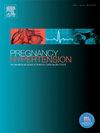Peripartum antihypertensive use and the risk of neonatal hypoglycemia and postpartum uterine atony: a retrospective cohort study
IF 2.9
4区 医学
Q2 OBSTETRICS & GYNECOLOGY
Pregnancy Hypertension-An International Journal of Womens Cardiovascular Health
Pub Date : 2025-06-25
DOI:10.1016/j.preghy.2025.101232
引用次数: 0
Abstract
Objectives
Determine whether peripartum antihypertensive use increases secondary uterotonic use, neonatal hypoglycemia, bradycardia, or NICU admission. Hypertensive disorders of pregnancy are common and increasing. Treatment includes beta- and calcium channel- blocking medications. Outpatient beta-blockers were associated with increases in neonatal bradycardia, hypoglycemia, and NICU admissions. Calcium channel blockers are weak tocolytics and may precipitate uterine atony and hemorrhage.
Study Design
Retrospective, single-center study at a tertiary academic hospital. Records of 26,058 parturients over 5 years were reviewed. We compared exposure to labetalol and nifedipine in separate analyses. We calculated univariate odds ratio and binomial generalized models to account for covariates. P < 0.05 was considered significant.
Main Outcome Measures
Primary outcomes were incidence of 1-hour neonatal hypoglycemia and maternal secondary uterotonic or antifibrinolytic use. Additional maternal outcomes were change in hemoglobin concentration and estimated blood loss; neonatal outcomes included hypoglycemia at 24-hours, bradycardia, and NICU admissions.
Results
We analyzed 24,845 records. Labetalol exposure occurred in 605 (2.4 %) deliveries and nifedipine in 426 (1.7 %). In multivariate analyses in the full cohort and matched cohorts, labetalol administration was significantly associated with 1-hour hypoglycemia (p < 0.001, OR 1.72, 95 %CI 1.33–2.23), but not 24-hour hypoglycemia (p = 0.12), bradycardia (p = 0.65), or NICU admissions (p = 0.86). Labetalol and nifedipine were associated with uterine atony (p = 0.006 and p = 0.027). Confounders and sensitivity analyses accounted for magnesium exposure, general anesthesia, and hypertensive diagnoses.
Conclusion
Labetalol exposure was significantly and independently associated with neonatal hypoglycemia. Any hypertensive use associated with uterine atony. Clinicians should consider 1-hour assessment of glucose in neonates born to labetalol-treated mothers.
围产期降压药的使用与新生儿低血糖和产后子宫张力的风险:一项回顾性队列研究
目的确定围产期降压药是否会增加继发性子宫强张性用药、新生儿低血糖、心动过缓或新生儿重症监护病房入院。妊娠期高血压疾病很常见,而且越来越多。治疗包括-和钙通道阻断药物。门诊-受体阻滞剂与新生儿心动过缓、低血糖和新生儿重症监护病房入院率增加有关。钙通道阻滞剂是一种弱促孕药,可引起子宫张力和出血。研究设计:回顾性、单中心研究,在某三级学术医院进行。回顾了5年来26,058例产妇的记录。我们在单独的分析中比较了拉比他洛尔和硝苯地平的暴露情况。我们计算了单变量比值比和二项广义模型来解释协变量。P & lt;0.05被认为是显著的。主要结局指标主要结局指标是新生儿1小时低血糖的发生率和产妇继发性子宫扩张或抗纤溶药物的使用。其他的产妇结局是血红蛋白浓度的变化和估计的失血量;新生儿结局包括24小时低血糖、心动过缓和入住新生儿重症监护病房。结果我们分析了24845条记录。605例(2.4%)分娩时暴露于拉贝他洛尔,426例(1.7%)分娩时暴露于硝苯地平。在全队列和匹配队列的多变量分析中,拉贝他洛尔给药与1小时低血糖显著相关(p <;0.001, OR 1.72, 95% CI 1.33-2.23),但没有24小时低血糖(p = 0.12)、心动过缓(p = 0.65)或NICU入院(p = 0.86)。拉贝他洛尔和硝苯地平与子宫张力相关(p = 0.006和p = 0.027)。混杂因素和敏感性分析解释了镁暴露、全身麻醉和高血压诊断。结论拉贝他洛尔暴露与新生儿低血糖有显著且独立的相关性。任何与子宫张力相关的高血压用药。临床医生应考虑对接受拉贝洛尔治疗的母亲所生的新生儿进行1小时血糖评估。
本文章由计算机程序翻译,如有差异,请以英文原文为准。
求助全文
约1分钟内获得全文
求助全文
来源期刊

Pregnancy Hypertension-An International Journal of Womens Cardiovascular Health
OBSTETRICS & GYNECOLOGYPERIPHERAL VASCULAR-PERIPHERAL VASCULAR DISEASE
CiteScore
4.90
自引率
0.00%
发文量
127
期刊介绍:
Pregnancy Hypertension: An International Journal of Women''s Cardiovascular Health aims to stimulate research in the field of hypertension in pregnancy, disseminate the useful results of such research, and advance education in the field.
We publish articles pertaining to human and animal blood pressure during gestation, hypertension during gestation including physiology of circulatory control, pathophysiology, methodology, therapy or any other material relevant to the relationship between elevated blood pressure and pregnancy. The subtitle reflects the wider aspects of studying hypertension in pregnancy thus we also publish articles on in utero programming, nutrition, long term effects of hypertension in pregnancy on cardiovascular health and other research that helps our understanding of the etiology or consequences of hypertension in pregnancy. Case reports are not published unless of exceptional/outstanding importance to the field.
 求助内容:
求助内容: 应助结果提醒方式:
应助结果提醒方式:


